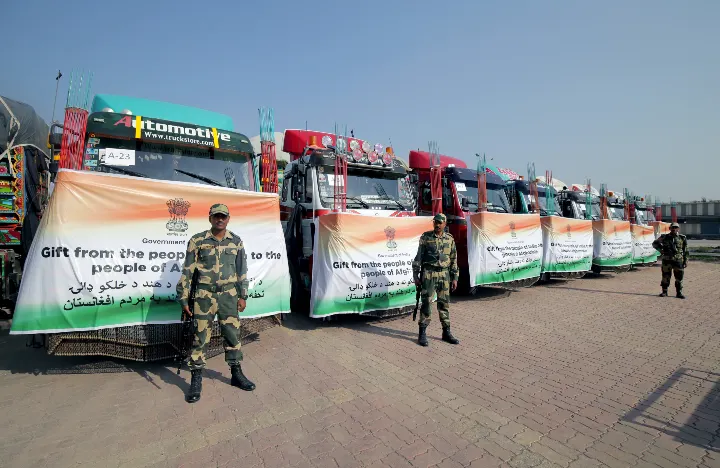

India's aid to Afghanistan
<p>
India has rushed nearly $3 billion in aid to Sri Lanka this year in the form of loans, credit lines and credit swaps as the nation battles an unprecedented economic crisis. This emergency aid to Colombo is almost as big as the assistance India provided to Afghanistan for infrastructure and institutional development over the years.<br />
<br />
The aid includes a $1 billion credit line for essentials, $500 million credit line for petroleum products, $400 million currency swap and over $1 billion under the Asian Clearing Union Framework. Under this assistance India also has been sending food items including rice.</p>
<p>
<img alt="" src="https://www.indianarrative.com/upload/news/India_medical_aid_Sri_Lanka.webp" style="width: 720px; height: 480px;" /><br />
<br />
<em><strong>Indian medical aid arrives for Sri Lankan hospitals (Photo: Indian High Commission)</strong></em></p>
<p>
Similarly, despite the regime-change in Kabul, India is continuing to provide wheat, life-saving medicines and other supplies to the Afghan people in their time of distress.<br />
<br />
India, which is one of the largest bilateral donors in Afghanistan globally, and the largest in the region, has built power lines, roads, dams, irrigation facilities, schools and hospitals in the war-torn country.<br />
<br />
The Indian assistance to Maldives has benefited its people directly.</p>
<p>
Speaker Mohamed Nasheed who was in India recently for the Raisina Dialogue was supportive of India. He said that Indian aid is transparent and hinted that people are satisfied as they know it provides livelihoods.<br />
<br />
Prime Minister Ibrahim Solih was profuse in his observations about Indian aid. In the national address in March this year, Solih said: &quot;In the last two years, India has generously aided us on many occasions. India donated the most number of vaccines. India purchased financial bonds worth $250 million to help recover our economy. We received a lot of equipment from India essential to provide health services&quot;.<br />
<br />
What is at play is India&#39;s Neighbourhood First policy that is designed to build friendly relations and achieve mutually-beneficial development goals in South Asia.<br />
<br />
Former Indian ambassador to Armenia and Georgia, Achal Malhotra says: &quot;Indian aid is usually non-prescriptive and benign. There is a qualitative difference when India provides aid. We have been doing it since the fifties but at that time we would provide less financial assistance but provide training and capacity building in good measure&quot;. &nbsp;<br />
<br />
He adds that under the Neighbourhood First policy, India is providing aid to help develop infrastructure and provide training to bureaucrats. &quot;Our development aid is a foreign policy tool to generate goodwill and improve political relations with neighbours&quot;.<br />
<br />
India, recently earmarked budgetary support for South Asian nations.<br />
<br />
Finance Minister Nirmala Sitharaman allocated Rs 17,250 crore for the MEA, of which Rs 6,292 crore is meant as development assistance to neighbours and countries in Africa and Latin America.<br />
<br />
This includes Rs 2,266 crore for Bhutan, Rs 750 crore for Nepal and Rs 600 crore for Myanmar. Among other neighbours, Maldives will get Rs 360 crore, Bangladesh Rs 300 crore and Sri Lanka Rs 200 crore in development assistance.<br />
<br />
The government also separately provided for Rs 6,043 for technical and economic cooperation with other countries–which is another of India&#39;s strong points.<br />
<br />
Associate Professor in the Department of International Relations at South Asian University, Dhananjay Tripathi says: &quot;India&#39;s role has increased in the last few years in providing assistance to neighbours. This is because of both the doctrines&mdash;Neighbourhood First as well as SAGAR&quot;.<br />
<br />
Tripathi says: &quot;Because of the changes in the Indo-Pacific region and China&#39;s increasing outreach to countries in South Asia, India had to increase its development support. Another important reason why India is providing aid and humanitarian relief is because India&#39;s global aspirations start from the South Asian region. If we have to be an influential power, we have to play a more determined and friendly role in the neighbourhood&quot;.<br />
<br />
Tripathi adds that countries like Maldives and Sri Lanka are on important trading routes. &quot;Our relations with Maldives go beyond China&#39;s intervention in South Asia. Modi and Solih enjoy strong personal relations. Also, Maldives is considered as a gateway to the Indian Ocean. Therefore, both Sri Lanka and Maldives are critical for India as neighbours&quot;.</p>
Sub Lieutenant Astha Poonia officially became the first woman to be streamed into the fighter…
As Israel awaits Hamas's response on Friday to the latest proposal for a hostage release…
Deputy Chief of Army Staff (Capability Development and Sustenance), Lieutenant General Rahul R Singh, on…
A report on Bangladesh's media landscape has revealed that the restrictive laws and political press…
Prime Minister Narendra Modi has said that India is actively working on creating a comprehensive…
The Indian Chamber of Commerce (ICC) on Thursday hosted the 14th India Minerals and Metals…